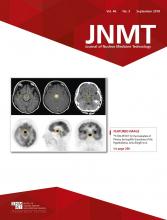Abstract
A 21-y-old man who presented with polyuria and polydipsia was discovered to have diabetes insipidus due to eosinophilic granuloma of the hypothalamus. 18F-FDG PET/CT, which was performed as a metastatic work-up, revealed an intensely 18F-FDG–avid hypothalamic mass and no other sites of disease.
Eosinophilic granuloma, a form of Langerhans cell histiocytosis, is very rare in the central nervous system. Langerhans cell histiocytosis can occur as a unicentric tumor or as multicentric aggressive disease. Therefore, Langerhans cell histiocytosis can present with various clinical manifestations, depending on the organ systems involved (1).
CASE REPORT
A 21-y-old man was referred to endocrinology for evaluation of diabetes insipidus with polyuria and polydipsia and associated hypernatremia. After initiation of desmopressin therapy and correction of his sodium level, T1-weighted brain MRI was performed with intravenous contrast material. The unenhanced sequence showed a hypothalamic mass with a signal intensity similar to that of gray matter (Fig. 1A), and the contrast-enhanced sequence showed strong enhancement of a 2-cm hypothalamic mass with smooth borders (Fig. 1B). Unenhanced CT was also performed, revealing that the mass was isodense to gray matter and had no calcification or hemorrhage (Fig. 1C). Given its pattern of enhancement and borders, a low-grade glioma or ganglioglioma was the primary consideration for the differential diagnosis (2).
(A–C) Transaxial T1-weighted unenhanced MR (A), T1-weighted gadolinium-enhanced MR (B), and unenhanced CT (C) images show hypothalamic lesion (encircled in yellow) to be strongly enhanced and isodense to gray matter. (D–F) Axial (D), sagittal (E), and coronal (F) 18F-FDG PET images reveal intense uptake in hypothalamic mass.
Because of the potentially devastating complications of surgery in this region, other treatment options such as radiation therapy and chemotherapy were discussed. A biopsy of the mass revealed numerous eosinophils with histiocytes, which were confirmed to be Langerhans-type cells (Fig. 2). Furthermore, immunohistochemical staining showed that the tumor was CD1a-positive, S100 protein–positive, CD117-negative, and CD34-negative. Overall, the pathologic findings were consistent with eosinophilic granuloma/histiocytosis. To evaluate for possible multicentric disease, 18F-FDG PET/CT was performed and showed a unicentric, intensely 18F-FDG–avid mass of the hypothalamus (Figs. 1D–1F), with no other 18F-FDG–avid lesions (Fig. 3).
Histopathologic photomicrograph (hematoxylin and eosin, ×400) shows numerous eosinophils and histiocytes (arrows).
18F-FDG PET anterior whole-body maximum-intensity projection shows intensely 18F-FDG–avid hypothalamic lesion (arrow) and no other sites of disease.
DISCUSSION
The biopsy of the hypothalamic mass in this symptomatic patient revealed eosinophilic granuloma. This disease has a wide spectrum of clinical manifestations that can make diagnosis and therapeutic response assessment challenging. 18F-FDG PET/CT has been shown to identify lesions in addition to those found on plain radiography, CT, and MRI (3,4). Furthermore, the utility of 18F-FDG PET/CT for monitoring response to therapy in a small number of patients has been reported (5). After multidisciplinary discussion by the tumor board, the patient was treated with radiation therapy.
CONCLUSION
Eosinophilic granuloma can present as unicentric or multicentric disease. In this very rare case of hypothalamic eosinophilic granuloma, 18F-FDG PET/CT was particularly critical given the high-risk location of the tumor, which made detection of distant metastases—requiring systemic rather than local therapy—even more crucial.
DISCLOSURE
No potential conflict of interest relevant to this article was reported.
Acknowledgments
We thank Carol Stuehm for her assistance in preparing the figures.
Footnotes
Published online May 3, 2018.
REFERENCES
- Received for publication February 15, 2018.
- Accepted for publication March 29, 2018.










